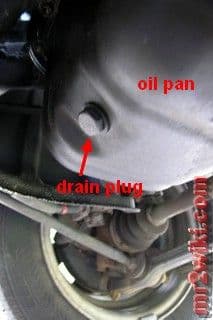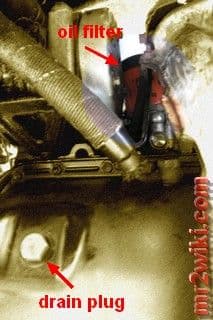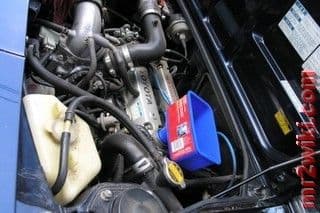Oil And Oil Filter
Oil should be changed at around 5,000 miles; synthetic oil can be changed less frequently (around 7,500-10,000 miles). Dealers will recommend changing every 3,000 miles – but they want to make money from changing oil, so they would.
Change the oil filter when you change the oil – you’re already under there, so you might as well.
The weight of oil you use will depend on your driving, weather, and engine conditions. Many people use fully synthetic oil, like Castrol Syntech SAE 10W30. The question of switching to synthetic is hotly debated, with little concensus. Some suggest that changing to synthetic will cause leaks, others say that’s a myth.
Preparation
- A 17mm socket is required for the oil drain plug.
- 3-4 quarts (US) of fresh oil.
- New oil fiter.
- An oil filter removal tool (optional). Very difficult to use in the limited space.
- Something to drain the oil into – an old bowl works fine.
- Funnel for refilling with new oil (optional).
- Lots of old rags to keep things clean.
- Rubber gloves – oil gets everywhere.
- Cardboard ground cover.
Drain the Oil
Changing the oil is best done after you’ve warmed the car up, and then let it cool for around 20 minutes. Warm oil flows better than cold, and the goal is to get as much oil flowing out of the oil pan as possible.
Do not perform this procedure when the car is still hot – hot oil will cause burns.
- Jack up the car.
- The oil pan and drain plug are just in front of the right rear-wheel:

- Put some old cardboard down under the oil pan to catch the oil splashes (there will be some):

- Put the bowl under the drain plug. The oil comes out pretty fast, and will be directed slightly to the front-end of the car (not vertically down), so put the bowl a little forward of the drain plug. As the oil drains the angle of the oil will become more vertical, so you may have to readjust the bowl.
- Use the 17mm wrench to loosen the drain plug. With the plug loose slowly turn it the rest of the way by hand. Once the plug is loose enough, the oil pressure will push the plug. The plug is magnetic, and so it will stick to the oil pan, and should not end up in the bowl!

- Once most oil has dripped out, clean the area around the drain plug opening. Replace the drain plug. You may want to replace the gasket, but this is not always needed.
- Use rags to wipe away any oil from the mounting surface on the block. If you leave oil on the block , it may smoke
- After you have filled the engine with fresh oil, pour the old oil into the containers and dispose of them appropriately.
Change the Oil Filter
Finding the oil filter is a little tough the first time, but it’s not difficult. The oil filter is slightly forward of the drain plug, and about 12-18 inches farther into the engine bay.

-
The filter simply unscrews. Before you loosen it, make sure you have a bowl or something underneath to catch the oil inside the filter. You can get better leverage if you lie with your feet towards the left-side rear wheel, and use your right hand to unscrew the filter.
If the filter is really tight, try using a filter wrench. Limitied space inside the MR2 make this tricky tough. A last resort if the filter is stuck tight and will not budge, is to jam a screw driver through the filter, and use that as a lever to twist. Obviously this is messy.
-
As the filter comes undone, make sure you keep the end that was screwed in poining upwards, otherwise the oil is going to come out!
-
Make sure the new filter has no debris inside it. Carefully rethread the new filter in place. Tighten by hand until the filter gasket contacts the seating surface; and then tighten an additional 3/4-turn. Do not overtighten.
Refill
For a few days after replacing the oil, keep a close eye on the oil level and oil leaks under the car.
- Make sure the oil drain plug and the oil filter are in.
- Refill with 3 quarts (US) of oil. Fill from the oil filler cap, using some kind of funnel:

- Check under the car to make sure no oil is leaking. Wait for a few minutes and check again, and check the oil dipstick – it should be close to full.
- Replace the oil filler cap.
- Remove all tools from under the car, and lower the car back to the ground.
- Start the engine and leave it running for a few minutes to let the oil circulate. Whilst it’s running check for leaks under the car.
- Turn the engine off, and wait a few minutes for the oil to drain into the oil pan.
- Check the level on the oil dipstick, and add oil if necessary to bring it close to the F mark.
